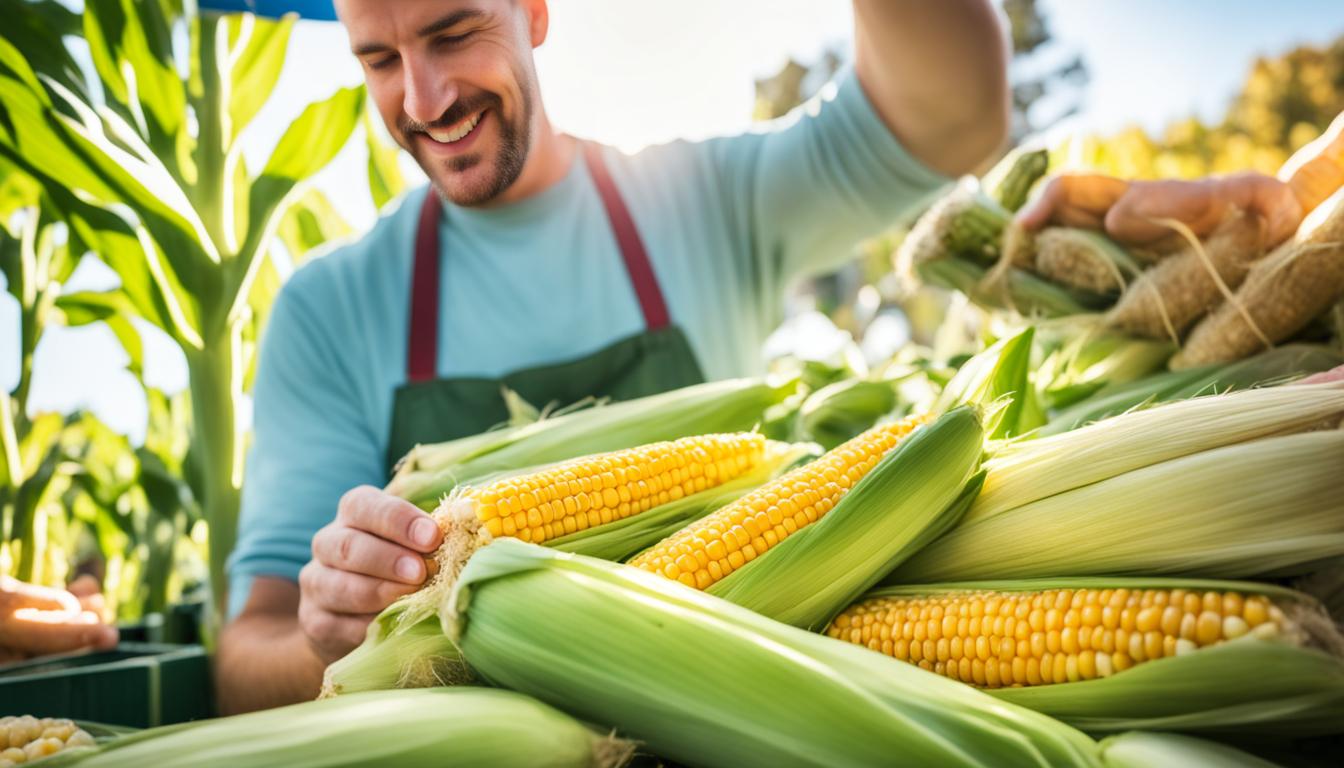Are you tired of buying corn on the cob only to find out it’s not as fresh or sweet as you expected? We’ve all been there. But fear not! In this easy guide, we’ll show you the secrets to selecting the freshest ears of corn and teach you how to prep cut fresh corn for your favorite dishes.
But first, let’s address the common belief that pre-shucked or pre-packaged corn is just as good as fresh corn. Is it really true? Is there a difference between buying fresh corn and pre-cut corn?
Now, let’s dive into the first step of our guide: how to buy the freshest corn to ensure you’re getting the tastiest kernels.
Selecting the Freshest Corn
When it comes to choosing fresh corn, we want to ensure that we’re selecting the highest quality ears for the most flavorful and delicious results. Here are a few tips to help you select the freshest corn:
- Look for bright green husks that fit snugly around the cob. This indicates that the corn is still fresh and hasn’t started to deteriorate.
- Avoid ears with yellowing or browning husks, as these are signs that the corn is past its prime and may not have the best taste.
- Peek at the top of the cob to check the kernels. They should be plump, firm, and intact, reaching all the way to the tip of the cob. This indicates that the corn is sweet and full of flavor.
- Examine the strands of corn silk between the husk and cob. Ideally, they should be pale green to white or light golden in color. If the strands are browning, dried up, or black, it may indicate that the corn is not as fresh.
Remember, it’s always best to consume fresh corn on the same day of purchase to enjoy its optimal flavor and texture. However, if you need to store it for a few days, keep it in the husk and store it loosely in a plastic bag to maintain its freshness.
Different Cooking Methods for Corn on the Cob
There are various cooking methods for enjoying corn on the cob. Whether you prefer grilling, boiling, microwaving, or roasting, each method offers a unique and delicious way to prepare this versatile vegetable.
Boiling Corn on the Cob
If you choose to boil corn on the cob, start by husking the corn and removing the silk. Then, bring a pot of salted water to a boil. Add the corn and cook for 2 to 3 minutes for crisp kernels or longer for softer kernels. Remember to adjust the cooking time based on your preferred level of tenderness.
Grilling Corn on the Cob
Grilling is a popular method for cooking corn on the cob, as it adds a smoky and charred flavor. Husk the corn and grill it on high heat for about 20 minutes, turning it occasionally to ensure even cooking. Alternatively, you can leave the husk on and soak the corn in water for about 30 minutes before grilling to help retain moisture.
Microwaving Corn on the Cob
Microwaving corn on the cob is a quick and convenient option. Leave the husk on and place the corn in the microwave. Cook on high for 3 minutes, then carefully remove the husk and silk. Be cautious as the corn will be hot. This method is ideal when you’re short on time but still want to enjoy delicious corn on the cob.
Roasting Corn on the Cob
Roasting corn on the cob is another flavorful cooking method. Start by husking the corn and preheating your oven to 450°F. Place the husked ears directly on the oven rack or wrap them in foil. Roast for about 20 minutes or until the corn is tender and slightly caramelized. This method intensifies the natural sweetness of the corn and adds a roasted smokiness.
Experiment with these cooking methods to find your favorite way to prepare corn on the cob. Whether you’re grilling, boiling, microwaving, or roasting, each technique delivers a unique and delicious corn-on-the-cob experience.
How to Prep Cut Fresh Corn
To prep cut fresh corn, start by removing the husk and silk from the ear of corn. Place the corn inside a large bowl to catch the kernels as you cut. Using a sharp knife, cut downward close to the base of the kernels while keeping the blade away from the cob. Rotate the ear of corn and repeat until all the kernels are removed. After cutting the kernels, you can scrape the back of the knife along the cob to extract the excess corn milk for added flavor.
If storing fresh corn, keep it in the husk in the refrigerator’s crisper drawer for up to a day. To freeze fresh corn, blanch the kernels in boiling water for a minute, then transfer them to an ice water bath to chill. Spread the blanched kernels on a baking sheet and freeze until fully frozen, then transfer them to a plastic freezer bag for storage for up to three months.
